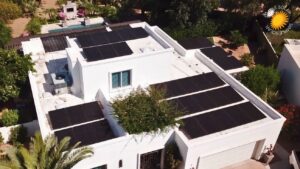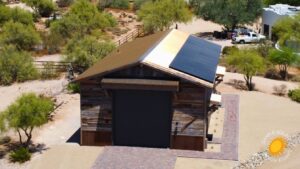If you have solar services, you have already lowered or maybe even eliminated your monthly power bill. But you may want to add panels to your existing solar array. Maybe your solar system was undersized when you had it put in. Maybe you have built an addition to your house, or your family has grown, or maybe you bought an electric vehicle (EV), so you need more electricity.
Four Things to Consider for Solar Array Expansion
Solar Array expansion isn’t quite the same thing as going solar for the first time. As you are shopping around for a contractor for your solar array expansion, there are several factors you need to keep in mind.
How Many Additional Panels Will You Need?
 The first step to consider before getting an expansion installation quote is the number of new solar panels your home needs. The best way to do this is to gather your home’s last 12-months utility bills. It is important to get the actual bills and not just total household consumption over the previous year. Consumption is only half the picture. On the bills, we can also see how many kilo-watt hours (kWh) were exported or sold back to the utility. This is important to consider because the credit accumulated will reduce your home’s overall annual consumption. The difference between these two numbers will be more reflective of what your home’s actual excess consumption is needing to be offset by additional solar on your roof. Once we know that number, we can then assess how many additional panels you will need.
The first step to consider before getting an expansion installation quote is the number of new solar panels your home needs. The best way to do this is to gather your home’s last 12-months utility bills. It is important to get the actual bills and not just total household consumption over the previous year. Consumption is only half the picture. On the bills, we can also see how many kilo-watt hours (kWh) were exported or sold back to the utility. This is important to consider because the credit accumulated will reduce your home’s overall annual consumption. The difference between these two numbers will be more reflective of what your home’s actual excess consumption is needing to be offset by additional solar on your roof. Once we know that number, we can then assess how many additional panels you will need.
Curious how many panels your home needs? Want to do a rough estimate on your own? Here’s how:
- Determine how much your excess energy need is in kWh’s per year. As mentioned above, you will need your last 12-months of bills and subtract your export/sold kWh’s from your total consumption kWh’s each month. Figure out the sum for the last 12 months, you then know what your home’s actual excess annual consumption is.
- Then take the average number of hours of sunshine in your area per year (in most of the Valley, that’s 3800 hours per year) and multiply by the wattage of the panel you intend to buy. The average output for panels today is 400 watts. So, multiply wattage of the panel by 3800, divide by 1000 to get a rough estimate of kilowatt hours produced by a single panel per year, and then divide that figure into the total number of kWh’s per year you need to generate/offset.
For Example (assuming your excess annual consumption is 10,000kWh’s and using a 400W panel):
3800 hours X 400 watts = 152,000 watts
152,000 watts / 1000 = 1,520kWh’s
10,000kWh’s / 1,520kWh’s = 6.6kW DC (6,600W System Size)
6,600W / 400W = 17 (panels needed for expansion)
This is a good exercise to get a rough estimate of expansion needs but is just a rough estimate. To get a specific and accurate estimate of system expansion size you can let Simple Solar do this for you.
Also, if you do not have 12-months’ worth of billing history, Simple Solar can assist you with an accurate estimate of what your additional annual need may be.
Do You Have Space For Additional Solar Panels?
Once you know how many additional solar panels you need, you need to make sure you have space on your roof to add them. Once again, math is involved. Multiply the footprint of the panel by the number of panels you need, and then compare that number to the available space on your roof. Consider whether you need to mount new panels in a ground installation. Or, again, let Simple Solar do this computation for you.
Will The New Panels be Compatible With Your Existing Solar Array?
 Using the same brand and model of solar panel to expand your existing solar array always looks better on your roof. But aesthetics isn’t your only concern when adding solar panels to your array.
Using the same brand and model of solar panel to expand your existing solar array always looks better on your roof. But aesthetics isn’t your only concern when adding solar panels to your array.
The racking and wiring of the new panels must be compatible with existing panels. The power output must be compatible, too, or you risk damaging your solar array.
If the same older components are not an option, you are not out of luck. Instead of expanding the existing array, you should think of it more like adding a second independent system that will also power your home. This is usually the preferred method as utilizing newer, more advanced technology and installation methods is usually more advantageous.
In the end it is important to consider the pros and cons of both options. Usually there is a clear choice and Simple Solar can aid in this decision using our experience.
Will Your Inverter be Large Enough to Handle the Increased Power?
Solar panels generate DC power. Household appliances and EVs need AC power. It is your inverter’s job to convert DC to AC. If your existing inverter is not up to the job, you may need to replace it.
If your contractor undersized your original inverter, there is a strong probability you will need to replace it when you expand your solar array. It’s OK to install an inverter with a power rating that is a little lower than the power rating of your panels, due to inefficiencies in the conversion of sunlight into electricity and the conversion from DC to AC. But if you increase the size of your panel array, it may generate more electricity than your old inverter can handle.
Two more considerations for expanding your solar array are making sure to take advantage of any tax incentives or rebate programs and getting all the construction permits and utility approval that are required for residential solar installation, even expansions. The rules are complicated and change all the time. This is something else Simple Solar can do for you.
What You Can Expect From Simple Solar
Simple Solar will never tell you that we will bring your electric bill to zero, but we can get your bill as close to zero as possible. We don’t recommend expansion for everyone, but give us 20 minutes, and we will do the calculations to determine what changes, if any, will work best for you. If expansion is what you need, Simple Solar has the most experience and offers some of the best options for expansion in the industry.
Request a quote online or contact us at (602) 587-5981 today!

